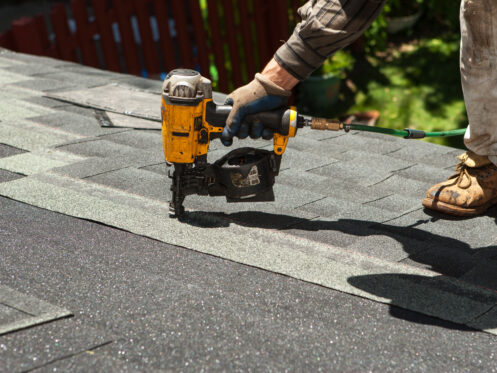When it comes to home improvements, installing energy-efficient roofing is one of the best investments you can make. This is especially true in an area like Carmel, IN, where seasonal weather fluctuations can put a strain on your utility bills. Energy-efficient roofing not only improves your home’s appearance but also helps reduce energy consumption, promote sustainability, and increase comfort, among other benefits.
1. Lower Energy Bills
Reducing utility bills is one of the most obvious benefits of installing energy-efficient roofing. Some traditional roofing materials can soak up a lot of heat from the sun, making your home hotter in the summer. This makes your air conditioner work harder, costing you more in energy. Reflective shingles are an example of energy-efficient roofing materials. They are designed to reflect more sunlight while absorbing less heat. This keeps your home cooler and puts less stress on your air conditioner.
2. Lower Environmental Impact
Many energy-efficient roofing options, including metal, clay tiles, and recycled asphalt shingles, are made from sustainable or recyclable materials. Metal roofs, for example, are frequently made from recycled steel or aluminum. When they reach the end of their useful life, they can be completely recycled. Clay and slate tiles are naturally abundant and highly durable, necessitating less frequent replacement and minimizing waste. By using these eco-friendly materials, homeowners not only reduce their environmental impact but also help to reduce landfill waste and conserve natural resources.
3. Boost Property Value
Homes with energy-efficient upgrades are often perceived as more modern, environmentally conscious, and cost-effective, attracting buyers looking for long-term savings. For example, energy-efficient roofing can reduce utility bills by up to 15%, making your home more affordable.
Furthermore, energy-efficient roofs frequently come with extended warranties, demonstrating their durability and low maintenance. A buyer who sees a new, energy-efficient roof with a 30- to 50-year lifespan is more likely to consider your home a better investment, reducing their concerns about future repairs. As more homebuyers prioritize eco-friendly and energy-saving features, installing energy-efficient roofing can boost your home’s resale value and set it apart in the competitive market.
4. Overall Durability and Longevity
Energy-efficient roofing systems are designed to be durable and long-lasting, often outperforming traditional materials in harsh environments. For example, some roofs are constructed with reflective granules or highly durable membranes that resist heat degradation. In Indiana, where summers can be hot and winters are bitterly cold, these materials help your roof withstand extreme temperature fluctuations without warping, cracking, or weakening over time.
Metal roofing is another option that saves energy. It can last 40 to 70 years and is resistant to fire, wind, and rust, so it is safer than asphalt shingles. Also, energy-efficient roofs often have better UV protection, which lowers the chance that materials will break down from being in the sun. Some materials, like clay tiles or slate, can be treated to make them more resistant to weather, so the structure will stay strong even in the worst conditions.
5. Tax Incentives
One significant benefit of installing energy-efficient roofing is the ability to qualify for tax breaks and rebates. Both federal and state programs frequently provide financial incentives to homeowners who invest in energy-efficient upgrades. For example, the federal Residential Energy Efficiency Property Credit entitles homeowners to a portion of the cost of installing energy-efficient improvements, such as qualifying roofing materials.
In Indiana, local utility companies may also provide rebates or discounts for upgrading to energy-efficient roofing that meets specific criteria. These incentives can help offset the installation costs, making the investment more affordable while encouraging homeowners to choose environmentally friendly options. You save money on energy in the long run while also benefiting from immediate tax savings.
6. Noise Reduction
Roofing materials that save energy can also be great at blocking out noise, making your home more quiet and serene. Roofing systems made of metal or insulation are two energy-efficient options that can also help block out noise from outside. For example, a thick underlayment or foam insulation can complement metal roofs so that heavy rain, hail, or nearby traffic sounds less loud. Another example of noise reduction in energy-efficient roofing is using multi-layered asphalt shingles. These shingles are designed with multiple layers of material that not only improve insulation but also absorb sound, making them effective at blocking out external noise.
Roofing materials like clay tiles or asphalt shingles absorb sound better than regular roofing, making the inside of a building quieter. This extra layer of noise protection can make a big difference in homes near busy roads or high-traffic areas.
7. Aesthetic Design
Energy-efficient roofing isn’t just good for performance. It comes in a lot of different styles that can make your home look better from the street. Modern materials that are good for the environment come in many styles, colors, and textures, so people can choose a roof that matches the style of their home. For example, roofing options come in the form of metal panels, reflective tiles, or even shingles that look like more traditional ones. You don’t have to compromise style to save money. You can pick from classic designs, earthy tones, or sleek modern finishes that go with the rest of your home’s look.
8. Prevent Ice Dams
When warm air from inside the house escapes through the roof, snow melts and then freezes again at the eaves, blocking the flow of water. This is how ice dams form. This water can get under the shingles and cause leaks, water damage, and even mold growth inside the house. Roofing materials that use less energy, along with good insulation and air flow, help keep the temperature of the roof stable. Energy-efficient systems keep heat from escaping through the roof, which makes it less likely that snow will melt unevenly and form ice dams. Some roof designs also include heat-reflective barriers that make temperature changes even less noticeable.
9. Better Indoor Air Quality
Roofs that are properly insulated help keep temperatures stable. This stops condensation that can cause mold growth, which is a serious health concern. Materials that are good for the environment may also have ventilation systems that help air flow, letting old air escape and letting new air in. This better ventilation cuts down on allergens and pollutants, making the space healthier to live in.
Contact Us Today
Installing energy-efficient roofing provides numerous benefits to Indiana homeowners, ranging from lower energy bills and improved comfort to increased property value and reduced environmental impact. Making this smart investment not only improves your home’s efficiency but also contributes to a more sustainable future.
If you’re considering upgrading your roof, now is a great time to investigate energy-efficient options that fit your style and budget. Contact Red Bird Roofing in Carmel to learn how you can transform your home with energy-efficient roofing and begin reaping the benefits right away! We offer roof replacement, roof repair, roof inspection, and roof coating. We also offer emergency repair, storm damage, tarping, and gutter work. Contact us today to schedule an appointment.






